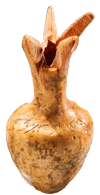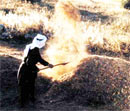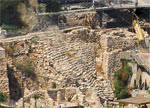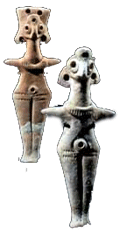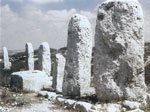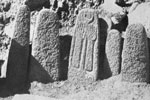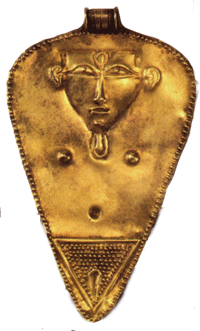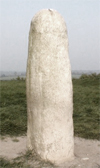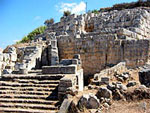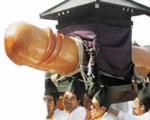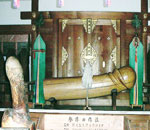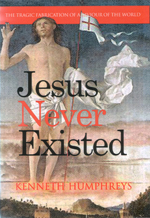"Solomon's pomegranate"
For 25 years this thumb-sized ivory pomegranate was the only "original artifact" ever found from Solomon's temple. It was exposed as a fake in 2004.
The bronze age bauble is actually far too old – but its "paleo-Hebrew" inscription was added in the 20th century!
The trinket netted the forgery ring $550,000 in 1988 and strengthened Jewish claims to Temple Mount.
The same master forger who owned the pomegranate – Oded Golan – was involved with the "James brother of Jesus" bone box scam that duped several biblical "authorities" in 2002.
Update October 2014
Hershel Shanks, editor of Biblical Archaeology Review and long-term defender of the authenticity of the pomegranate, confesses "he now has doubts."
A "threshing floor"
It requires a very special patch of ground for tossing wheat: the wind has to blow.
The one thing you wouldn't want for your "floor" is a lumpy rock outcrop with a hole in it – as found under the Dome of the Rock.
A Canaanite settlement
The Jebusite city on the eastern hill has nothing to do with a "King David" but the Jewish hero gets the credit.
The so-called "City of David" occupied a hilltop barely 200 by 600 yards. Nothing "Davidic" has ever been found here but numerous Astarte figurines – fertility symbols of the Canaanites – have been.
"And Judah did evil in the sight of the LORD ... For they also built them high places, and images, and groves, on every high hill, and under every green tree." – 1 Kings 14.22,23.
Gezer (Tel el-Jazari), A row of ten monoliths from a Canaanite cult centre on a hilltop 30 km west of Jerusalem.
Hazor – standing stones, possibly in honour of a moon goddess.
Some stone shrines were less acceptable than others. The priests of Yahweh codified "jealousy" as the first commandment of their vicious deity.
"If your brother, son, daughter, wife or friend ... say, Let us go and serve other gods ...the gods of the people round about you... you shall surely kill him; your hand shall be first upon him to put him to death." – Deuteronomy 13.6-10.
Asherah – Mrs God
Gold plaque of fertility goddess Asherah, excavated from ancient Gaza (Tell el-Ajjul) in the 1930s by Sir Flinders Petrie.The popular goddess seriously angered the spin-doctors of Yahweh:
"See what they do in the cities of Judah and in the streets of Jerusalem? The children gather wood, and the fathers kindle the fire, and the women knead their dough, to make cakes to the Queen of Heaven ...
Behold my anger and my fury shall be poured out upon this place, upon man, and upon beast, and upon the trees of the field, and upon the fruit of the ground; and it shall burn, and shall not be quenched. Thus said the LORD of hosts, the God of Israel."
—Jeremiah 7:17,21.
* The number is palpably ridiculous. The walled city of Jerusalem (of a much later date), scarcely a square mile of enclosed space, could probably accommodate 5-10,000 inhabitants.
A labour force of 150,000 exceeds the total Herodotus says built the pyramid of Khufu and modern estimates are one-tenth of that.
|
Two enigmatic cultic pillars?
"And he set up the pillars in the porch of the temple: ... the right pillar, called Jachin, and the left pillar, called Boaz." – 2 Kings 7.21.
A Persian Temple on the coast
Temple of Eshmun, Sidon, Lebanon.
Eshmun was a healing/fertility god. The sanctuary was built in the Achaemenid imperial style during Phoenica's Persian period (6th-4th century BC).
In Levantine mythology, Eshmun was a mortal who died at his own hand but was restored to life as a god by Astarte.
The "Temple of Solomon", centrepiece of an ancient imperial capital and Yahweh's very own residence on earth, has ever cast its chimeric shadow over the Jewish people. The fabulous sanctuary has engaged the interest and excited the imagination of enthusiasts of the esoteric ever since the yarn of the mighty Jewish king was first told. Solomon's arcane wisdom, supposedly encoded within the very measurements of the Temple itself, sustained Freemasonry for centuries. The purported clandestine activities of mediaeval Templars and Kabbalists have been regularly woven into complex "mysteries" in which lost treasures, even artifacts of the divine, await the intrepid. But for all the adventure, and considerable baloney, in reality, not a single stone of the Temple – nor the entire Solomonic theme park for that matter – has ever been unearthed. In recent times, a single 4-centimetre pomegranate, the "ornamental barb of a priestly staff", enjoyed fame as the sole evidence of the Temple's existence – until it too was exposed as fake! Why the deceit? For the priesthood of Judaism the grand illusion of a Temple of Solomon was a necessary one: it supported both the myth of God's patronage of the chosen people and the comforting dream of a once and future empire. This simple tale of fantasy and fraud begins with the purchase of a hilltop and leads rapidly to mass murder. But then, we are talking of religion.
A house for Yahweh
In Jewish mythology King David, after slaughtering Philistines wholesale by a strategy of blitzkrieg, seized the Jebusite city of Shalem by stealth. He then chose to buy the top of the nearby high place (Mount Moriah) from Araunah the Jebusite (2 Samuel 24.16) – or if you prefer, from Ornan the Jebusite (1 Chronicles 21.15). He paid Araunah 50 shekels of silver – or if you prefer, he paid Ornan 600 shekels of gold. Either way, it seems our Jewish hero legitimately took possession of a "threshing floor" – a motif of integrity copied from Abraham's "purchase" of the Cave of Machpelah from Ephron the Hittite featured in Genesis 23. Upon this newly purchased hilltop – remarkably the very place that Abraham had bound Isaac, ready for sacrifice – David built an altar and offered burnt offerings to the badgering deity of the Jews. Yahweh was clearly delighted – he called off the plague with which he had been harrying the Jews. Even so, David's hands were too "bloodied" to build his god's earthly residence – that honour was left to David's son Solomon. Court wizard Nathan was God's mouthpiece as he vowed to David:
But what sort of house? It is reasonable to assume something rather better than the ornate tent formerly used for the Ark of the Covenant in the wilderness years. God had very exacting requirements for his earthly residence. Bizarrely, he wrote his plans for the temple, including its dimensions and furnishings, onto David himself (1 Chronicles 28.19). This included a punctilious listing of candlesticks, bowls, shewbread tables, fleshhooks and even a "chariot of the cherubims" – all in pure gold, of course. Supposedly, this grandiose temple was actually built and, true to his promise, a godly presence took up residence:
Endless dynasty, endless gold?
But even before all that supposed plundering by Judah's monarchs the treasury had first been emptied in the time of Rehoboam – Solomon's own son who went "bad". It seems the dust had hardly settled on Solomon's handiwork before God's punishment – in the guise of pharaoh Shishak – arrived at Jerusalem and "took away the treasures of the house of the LORD ... he even took away all" (1 Kings 14.26). Which makes it rather curious that Johoash, 8th century king of the northern Jewish kingdom of Israel, could turn up at Jerusalem, destroy much of the city wall, and also take "all the gold and silver, and all the vessels that were found in the house of the LORD" (2 Kings 14.14). The treasure house of Yahweh clearly had a propensity to refill itself rather rapidly. Real history intrudes in 586 BC with the destruction of Jerusalem wrought by the Babylonians. Even then, according to the Bible, it is "Solomon's gold" which is sequestered – and even more curiously, returned sixty years later, despite being "cut up"!
Fantasia – the Temple of Solomon
Nothing at all confirms biblical claims of a monumental structure, despite the plethora of models fashioned after the details so reverentially recorded in the Tanakh. The Temple's "symbolic" existence is palpable: every part of this "earthly heaven" was overlaid with pure gold – including apparently a porch that soared 180 feet into the air! (2 Chronicles 3.4). Its construction in seven years and dedication in the seventh month clearly reflected the seven days of creation. The fabulous Temple was a motif of heavenly perfection and the earthly residence of "divine glory". Functionally it was "God's footstall" and the place where he spoke to his people. The immense wealth and consummate skill required to have ever built the purported temple and then to have fashioned the elaborate paraphernalia of sacrifice and ritual – way beyond the reach of a petty iron age kingdom – underscores the pious fantasy of it all. And the Temple was but one of several grandiose buildings attributed to Solomon which have left no trace. The book of Kings claims that a labour force of over 150,000* was set to the task of building the temple yet at the same time it accredits a single named artisan – "Hiram of Tyre" – with a prodigious quantity of work. This included everything from two giant brass pillars (covered with hundreds of pomegranates), decorative lions, oxen, and cherubims, to chains and shovels. One item alone, a "molten sea" – a thirty ton bronze basin mounted on twelve bronze oxen – held over 10,000 gallons of water. As if.
Reality check – Stones in High Places
The Israelites adopted the practice of erecting standing stones and continued to worship at "pillars" throughout their history. Only after contact with their more civilized neighbours – Assyria and Babylon – did they copy the more sophisticated temple-style sanctuary. The Bible actually relates that all the major Jewish heroes followed the practice of erecting, anointing and sacrificing at stones in "high places":
Grove on Temple Mount An indication that standing stones and a "sacred grove" really graced Temple Mount is found in the campaign of desecration and murder so gleefully attributed by the books of Chronicles and Kings to king Josiah of Judah. The regency of this young, 7th century BC king provided the priests of Yahwism with the opportunity to eradicate rivals to the Yahweh cult and at the same time impose an exclusive, Jerusalem-based theocracy. Even rural priests of the Yahweh cult were to be compelled into service with the sacerdotal hierarchy in Jerusalem. Josiah "did that which was right in the sight of the LORD" and waged a fierce campaign of terror against rivals of Yahweh worship. Priests were murdered and burnt on their own altars, images were smashed, sacred groves destroyed and even the graves of children defiled. All God's work. The biblical account may well exaggerate the success of Yahwism's violent program of religious purification but it certainly confirms that a plethora of gods, groves and altars in "high places" peppered the Palestinian landscape. So tenacious was the appeal of other deities that even even after the iconoclasm of Josiah most of the kings of Judah continued to embrace a multiplicity of gods and even rebuilt the "high places".
Sex Gods on Mount Moriah
Whatever else, there is little to suggest that the Yahweh sanctuary ravaged by Josiah had much in common with the fabulous "Temple of Solomon" of later fame. The site evidently featured a grove and altars to Baal, Ashtoreth (Astarte/Ishtar) and other gods. To the priests of Yahweh this was surely "the mount of corruption" (2 Kings 23:13) – not the Mount of Olives. Astarte figurines are found in ancient sites throughout the Levant. The ubiquitous Asherah worship – more popular than the vengeful god Yahweh – celebrated the creative union of male and female, Baal with his consort Astarte. Even the Bible provides disguised confirmation of the fertility cult in Jerusalem with its curious references to "sodomites" and "women weaving" in 2 Kings 23.7. The word used for sodomites here (qadesh) refers not to homosexuals but to prostitutes consecrated to the goddess. The innocuously described "groves" for which the women of Jerusalem were weaving "hangings" were not leafy orchards but trees carved to represent the "staff of life" – the erect phallus. These virile poles would be raised aloft mounted in drilled foundation stones. This portability made it possible for them to be "brought out" and "burned in the Kidron valley". The woven adornments hung upon them represented the "door of life" – the receptive female organ. The writer Lucian of Samosata, in the 2nd century AD, reports a comparable cult in his native Syria.
"Look what we've found"
In reality, the text functions as a guidebook to Josiah's rampage, almost certainly penned during the Babylonian exile, a century after the event. It even refers to casting the dust of a shattered idol "into the brook that descended out of the mount" (Deuteronomy 9.21) – arrestingly similar to 2 Kings 23.12 "cast the dust of them into the brook Kidron." The new scripture – Deuteronomy – introduced rules on everything from cross-dressing to war brides. Seventeen times the text warns against "going after false gods" and graven images. Fourteen times it makes reference to the exclusive privileges of the "place which the Lord your God shall choose to put his name" – an oblique reference to Jerusalem. The Levites are endorsed as an elevated priesthood. The cult of kingship, although endorsed, is now circumscribed by "Mosaic Law" as interpreted by a privileged priesthood (Deuteronomy 17.15-20). The modest first Yahweh temple on Mount Moriah in all probability was that associated with the Josiah/ Deuteronomy reformation.
A Persian temple?
The sojourn of the elite of Judah in exile proved crucial. A half-century of acculturation transformed the priesthood and its Yahweh cult. With the accession of Cyrus, it seems a force of Persian-sponsored returnees were charged with a temple building project in Jerusalem, beginning with an altar. The book of Ezra credits both the Jewish god and a succession of Persian kings for the "reconstructed" temple:
Some idea of this "second" temple may be gleaned from the remains of another Persian-sponsored sanctuary from the same time: the Sidonian temple of Eshmun. Almost certainly the two temples shared design features. But unlike impoverished Jerusalem, Sidon was a wealthy, cosmopolitan trading city with a powerful fleet in the service of the Persian empire.
The "Second Temple"
Ezra 6.3 describes the "strong foundations" of the Second Temple, and a height and breadth of "threescore cubits" (90 feet?) – considerably larger than the purported original structure of Solomon (breadth 20 cubits, height 30 cubits, length 60 cubits – 1 Kings 6.2). Once again, we are in the realm of the fabulous. The 1st century Jewish historian Josephus offers us a more convincing description of this structure, which is certainly much smaller than the fabled Solomonic prototype:
It seems the "second temple" had none of the fantasy fitments of the Solomonic temple, such as the Ark of the Covenant (which mysteriously disappears from the story after the Babylonian intrusion), the priestly breastplates of divination ("Urim and Thummim"), the giant golden cheribim which stood in the holy of holies, the bronze serpent of Moses that cured snake-bite – nor even a genuine pot of manna! (Hebrews 9.4). The temple's lacklustre appearance compared to the purported original apparently caused old men who remembered Solomon's temple (very old men!) "to weep" (Ezra 3.12). But then how could the works of man compare with a priestly fantasy?
Temples on the Mount – Part Two
Sources:
'Save' a friend e-mail this page
Copyright © 2008
by Kenneth Humphreys.
|
||||||||||||||||||||||||||||||||||||||||||||||
